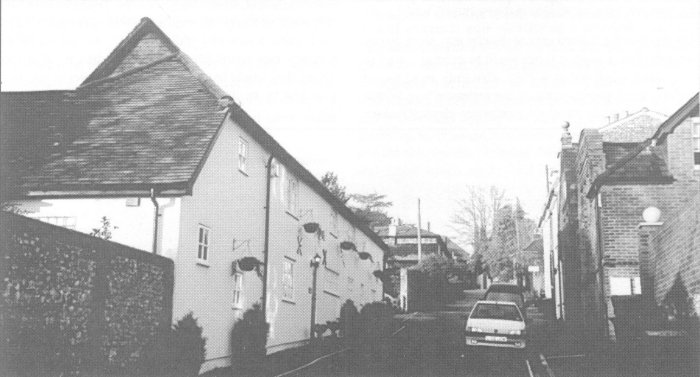Trust Member's Choice - TrustNews Spring 1997
We continue our series of 'special corners' of Winchester chosen by members of the Trust. The invitation is repeated to anyone interested in contributing to a further newsletter with a favourite place, to write to the Editor. As demonstrated in the Summer Newsletter, these choices give an opportunity to discover some lesser known parts, or views, of Winchester.
St James Terrace
Sylvia and Hugh Jobling write:

St James Lane
Walking along St James Terrace twice a week throughout the year we are aware of the beautiful gardens fronting these elegant houses - gardens which reflect the changing seasons so tastefully. In the Winter, when the gardens are dormant, one is still aware through the windows of the houses of the gardeners who give so much pleasure to passers-by. Crossing St James Lane and entering the cemetery, the view of the hills when you turn and look back is again a wonderful view at all times of the year.
Mews Lane
Felicity Hill writes:
A favourite place of mine is one you may not know, for Mews Lane is very tucked away (a cul-de-sac off a cul-de-sac!), but it divides a small area between Romsey Road and St James Lane which has an interesting history.
This must once have been fields, pasture or arable perhaps, and was bounded on its western edge by the medieval church of St James. The church is long gone, but its ancient graveyard still survives and was lovingly described by Regine Tatham in the June 1996 Newsletter.
The first confirmed use of my chosen area was as a large Jewish cemetery in the 12th and 13th centuries. Graves have been discovered over a period of development from the excavation of the railway cutting in 1838 up to the present day. Higher up there was a later cemetery, for a map of 1836 shows a "Soldier's Burial Ground" at the top north side of Mews Lane, where the Southern Water Pumping Station now stands. This may have been established in 1796 when the palace designed for Charles II became an army barracks.
The first housing development was the construction of St James Terrace around 1842. The stables and coach houses in Mews Lane, built at the same time, belonged to the big houses in St James Lane (described in the Hampshire Chronicle of January 1842 as "handsome villa residences for genteel families").
St James Terrace, an attractive row of houses in the Georgian style, remains largely unaltered. Some houses had stabling, now replaced by garages. The rest may have used St James Mews, a livery stable at the corner of Crowder Terrace and Mews Lane. This became a school in 1893 and was converted into houses in 1995.
Most of the domestic stabling in Mews Lane survives, as cottages or garages. Glancing up the lane it still has an earlier century look, so it is easy to imagine the bustle of horses and grooms, and digging in our gardens we unearth horseshoes and broken clay pipes, bits of pottery and oyster shells!

Mews Lane
The Cathedral Refectory
Chris Honey write:

The Cathedral Refectory
Winchester's venerable charms and modest distinctiveness have been nurtured - not always entirely with care - through so many years. It is, as a whole, a pleasant place to be - a degree of integration that's unusual to find.
One small building - just a remarkable church (or Pilgrims') hall - gets my vote for 'favourite' because it is so new, amongst the old. It is refreshing indeed. The Cathedral Refectory is steel-and-glass modern with a wholistic input of product design and lateral thought.
The building itself is of high quality. Not some over-ornate "gilded cage". but ordinarily well-assembled, integrated with integrity. of good wearing materials (brick, stone, lead and slate) that resonate politely and well with the buildings around. The steel structure and glass wall add lightness, daylight and view, and assert the "modern "decades - with added panache because of the hideawa, approach through little barns / garden sheds from the spacious cathedral west front. The only disappointment is the plethora of new handrails cluttering the main approach -prune these away for the sake of the West Front.
The activities housed in the building are important above all. Refreshment - modern hospitality for pilgrims - of a calibre to suit both the world travellers and genteel. This modern "hospitalit: tent" and kitchen is a crucial adjunct to the Cathedral's modern role. Serviced with good catering and caring staff, this hospitality is a reviving source of refreshment for head, heart and hands.
